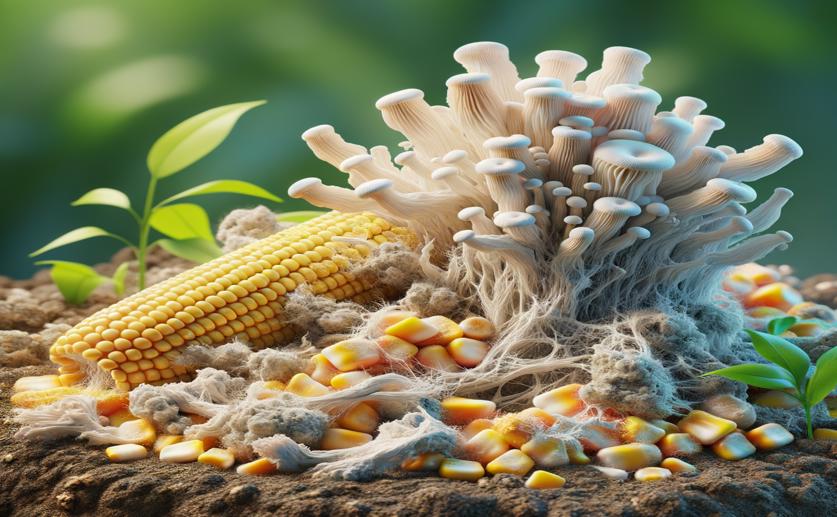Tracking Corn Waste Breakdown by a Common Fungus

Image Source: Natural Science News, 2024
Key Findings
- Researchers at Heinrich Heine University Düsseldorf found that the fungus Ustilago maydis can grow using untreated corn stover, a maize byproduct, as its sole carbon source
- U. maydis primarily uses soluble sugars in corn stover, with limited use of more complex lignocellulosic carbohydrates
- Biotechnological strategies, including enzyme cocktails and genetic engineering, improved U. maydis's ability to break down complex carbohydrates, enhancing performance by up to 120%
The sustainable bioeconomy aims to recirculate renewable agricultural waste streams into valuable products, reducing waste and promoting environmental sustainability. A promising approach in this field involves the use of Ustilago maydis, a fungal maize pathogen, to convert corn stover—an abundant byproduct of maize crops—into high-value compounds. Researchers at Heinrich Heine University Düsseldorf have demonstrated that U. maydis can grow using untreated corn stover as its sole carbon source, marking a significant step forward in sustainable bioconversion processes[1].
Corn stover contains various carbohydrates, including soluble sugars such as glucose, sucrose, and fructose, as well as more complex lignocellulosic carbohydrates. The study revealed that U. maydis primarily utilizes these soluble sugars, with limited exploitation of the lignocellulosic components. To enhance the fungal utilization of lignocellulosic carbohydrates, the researchers explored several biotechnological strategies. These included using a maize mutant with increased biomass digestibility, co-fermentation with commercial cellulolytic enzyme cocktails, and engineering U. maydis strains to express diverse lignocellulose-degrading enzymes. These approaches resulted in additive performance improvements of up to 120%.
This research builds on previous studies that highlight the versatility and potential of U. maydis in biotechnological applications. For instance, U. maydis has been used as a model organism for understanding plant-pathogen interactions[2] and has demonstrated the ability to grow on various carbon sources, including plant tissues, which induce different lytic enzymes[3]. These enzymes are crucial for breaking down complex carbohydrates, making U. maydis an ideal candidate for bioconversion processes.
Moreover, the study aligns with earlier findings on the Ustilaginaceae family, which includes U. maydis, as a promising source of biotechnologically relevant products such as mannosylerythritol lipid (MEL) biosurfactants. These biosurfactants have numerous applications, and the use of a chemically defined mineral medium has shown to support the growth and MEL production of various Ustilaginaceae species, including U. maydis[4]. The current study's focus on using untreated corn stover as a carbon source complements these findings by providing a more sustainable and cost-effective substrate for microbial production.
The researchers developed a small-scale bioreactor platform to investigate the processing of corn stover by U. maydis. This platform allowed for the online monitoring of fungal growth and metabolic activity profiles, as well as biochemical analyses of the pre- and post-fermentation residues. Such detailed monitoring is essential for optimizing the bioconversion process and scaling up production.
In summary, the study by Heinrich Heine University Düsseldorf demonstrates the potential of U. maydis to utilize untreated corn stover for the production of high-value compounds. By enhancing the fungal utilization of lignocellulosic carbohydrates through various biotechnological strategies, the research marks a significant advancement in the field of sustainable bioeconomy. This work not only provides a tool for detailed monitoring of fungal processing but also paves the way for scaling up the production of sustainable compounds from agricultural waste.
BiotechPlant ScienceMycology
References
Main Study
1) Monitoring corn stover processing by the fungus Ustilago maydis.
Published 14th September, 2024
Journal: Bioresources and bioprocessing
Issue: Vol 11, Issue 1, Sep 2024
Related Studies
3) Induction of lytic enzymes by the interaction of Ustilago maydis with Zea mays tissues.
Journal: Fungal genetics and biology : FG & B, Issue: Vol 29, Issue 3, Apr 2000
Related Articles





 19th July, 2024 | Jenn Hoskins
19th July, 2024 | Jenn Hoskins